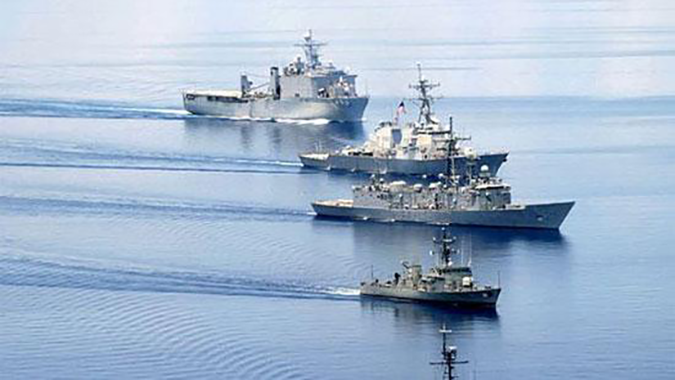FEATURES
Sri Lanka sails into murky waters in the Red Sea

By Uditha Devapriya
Speaking at an awards ceremony on Wednesday, January 3, President Ranil Wickremesinghe announced that the government would be deploying a Navy vessel to the Red Sea. Wickremesinghe pointed out that the disruption of shipping lanes in the region would lead to increased freight charges and cargo costs, increasing import prices in the country. Arguing that this was not in Sri Lanka’s interest, he declared that the government would do what it could to contribute to stability in the region.
The announcement came as a surprise to many, not least since the President revealed it only towards the tail-end of his speech. Soon after, the government launched a feasibility study for the proposal. The President had earlier admitted that deploying a vessel would cost the government Rs 250 million every fortnight, while a Navy spokesman stated that the Red Sea operation required clear “logistics supplies” and “a robust weapon outfit.” Meanwhile, on social media and in the press, commentators and analysts weighed in on the proposal, many expressing scepticism at and condemning the move.
The Sri Lanka Navy has since confirmed that it will be despatching a number of vessels to the region. While no date has been finalised yet, the Navy has stated that the deployment will be in support of Operation Prosperity Guardian, the United States led initiative combating Houthi rebels in the Red Sea. The rebels have vowed not to back down until Israel ends its attacks on Palestine. Since December, they have planned and carried out a series of drone and missile strikes which have forced cargo ships to reroute. In response, several countries, including India, have deployed vessels to the region.
Sri Lanka is the latest country to join these efforts, but its entry seems to have left more questions than answers. For one thing, the Red Sea operation marks the first major military confrontation between the US and the Houthi rebels. This has several crucial geopolitical implications.
On the one hand, the US and its allies have justified their intervention on the grounds of protecting international trade and shipping lines, while the Houthis have justified their attacks as a show of solidarity with Palestine and Gaza. On the other, the rebels are allegedly backed by Iran, which has so far belittled or ignored US warnings, and has gone so far as to deploy a warship in response to escalating tensions.
Complicating matters further, US allies themselves seem less than forthcoming about their involvement. When Washington launched Operation Prosperity Guardian in December, the Pentagon announced a united campaign of several countries, many from Europe. Yet apart from a few like the UK, most of them have kept their participation under wraps. The more forthcoming among them have made relatively modest contributions, while key allies such as Germany have been ambivalent about the extent of their intervention.
On the face of it, Europe’s indecisiveness has left an opening for US allies in other regions to assert their strength in the Red Sea operation. India, for instance, has despatched escorts, including frigates and destroyers, for Indian container ships.
The United States has invited Delhi to join its coalition, the Combined Maritime Forces, expanding its reach in the Red Sea as well as in adjacent regions. Yet while India has been willing to commission vessels to the Red Sea, it has preferred to maintain its own presence rather than joining a coalition. As of now, tellingly, no Asian country apart from Bahrain – the sole Gulf country to join – has deployed vessels for the operation; Singapore and Seychelles have agreed to take part, but only to contribute to information sharing.
Sri Lanka’s willingness to join with US forces is hence perplexing. Ostensibly, it is filling a gap no other Asian country has: in December, it became the 39th country to join the Combined Maritime Forces partnership. While details of the vessels that will be despatched to the Red Sea have yet to be confirmed, reports indicate they will be stationed outside the immediate Houthi weapons range, given the near absence of air defence and counter-missile systems in Sri Lankan Offshore Patrol Vessels (OPVs). When these vessels enter the Red Sea, they will be placed under the command of US Task Force 153.
Yet, however perplexing these developments may be, they are hardly unpredictable. The Sri Lankan and the US Navies have been engaging and cooperating with each other for a fairly long time. Last year, for instance, they embarked on a series of training sessions to prepare for disaster relief and “maintain a free and open Indo-Pacific.” These exercises and sessions will be conducted this year as well.
The US Navy has also handed over ships and coastguard cutters to the Sri Lankan Navy. In fact, two of the three ships which have been proposed for the Red Sea operation, SLNS Gajabahu and SLNS Vijayabahu, were gifted by the US in 2018 and 2021 respectively. Given these engagements, the Sri Lankan Navy’s willingness to deploy ships to the Red Sea under the US Fleet’s command is not entirely surprising.
There are arguments for and against the proposal on both the domestic and foreign policy front. On the domestic front, perhaps the biggest concern is cost. The operation is expected to burn up LKR 250 million or USD 777,000 every two weeks. The government has justified the expense on the basis that securing the Red Sea would help stabilise import prices. On the face of it, this is true. Marine insurance rates have more than tripled since the rebels began their campaign in the Red Sea, while at least one major shipping line has diverted to the longer alternative route around the Cape of Good Hope.
But Opposition lawmakers, critics of the government, and ordinary citizens have denounced the proposal on the grounds that it brings no immediate benefit to Sri Lanka. The Leader of the Opposition Sajith Premadasa, for instance, questioned the need for such a campaign at a time when people were reeling from grinding austerity, including an unpopular Value-Added Tax which has led to massive price hikes nearly everywhere, and on every item.
Predictably, the move has also been condemned as hypocritical: while forcing Sri Lankans to practice economies at home, the government is doing the exact opposite abroad, and what’s worse, as the country’s leading political and foreign policy commentator Dr Dayan Jayatilleka observes, in a conflict that is “not our fight.”
According to political researcher and archivist Uthpala Wijesuriya, however, the problem hasn’t just to do with cost, but also with capability. While there has been no shortage of supporters of the proposal who confidently point at the Sri Lankan Navy’s past successes, including its operations against illegal drug peddling in the Arabian Sea and its supposedly untarnished historical record, the Navy relies almost exclusively on vessels gifted by foreign governments which have the latest capabilities. “The question in that sense isn’t whether we have money for these kinds of operations, but whether we have the capabilities we need and if not, who is going to give them to us,” Wijesuriya argues.
This is a valid concern. On the other hand, though, former Chief Hydrographer of the Sri Lankan Navy Rear Admiral Y. N. Jayarathna (Retd.) sees the proposal as a massive investment opportunity for the country’s military. He estimates that Sri Lanka’s OPVs require equipment like thermal cameras and stabilised platforms, and argues that the government’s decision could spur investments in such “operational necessities.” While conceding that the media may portray the government as a “US partner” vis-à-vis its operations in the Red Sea, he contends that it is time the Navy extends its activities to areas like the Gulf of Yemen and the Arabian Sea in partnership with other countries.
At the same time, however, international relations commentator Rathindra Kuruwita argues that there is a manpower problem in the military. “Motivation is at an all-time low in the army and the navy, because their members are feeling the impact of austerity, reduced food rations, and so on.” Against such a backdrop, Kuruwita says that no number of investments would motivate them to embark on such a risky mission in the Red Sea.
Moreover, perceptions of the Sri Lankan government joining up with US forces could make Sri Lanka vulnerable to attacks abroad, especially since the Houthis have vowed retaliation on anyone joining the US coalition. This has only been compounded by what Kuruwita views as Sri Lanka’s problematic stance on the Gaza issue.
“On the one hand, we are voting with the rest of the Global South on Palestine at the UN,” he says. “Yet on the other, we are sending our youth to Israel to meet labour shortages there after they expelled Palestinian workers.” According to Kuruwita, the Gaza issue has become particularly sensitive for Muslims in Sri Lanka and everywhere else. “The government is now acting in a way that is hurting their feelings. That could generate a backlash in the not-too-distant future.” All that, he concludes, could boomerang on the country, particularly as the Houthis have vowed to attack any ship connected to Israel, and the Sri Lankan government is about to join the US, Israel’s number one military partner, in the Red Sea.
These developments underlie the immense complexities that Sri Lanka faces in the current geopolitical context. The decision to deploy vessels to the Red Sea has turned the Sri Lankan Navy into more than just a passive bystander; it has turned it into an active participant in the tensions erupting in the region. While supporters of the decision may make grandiose claims about the Navy’s past successes, there is no doubt it has opened a can of worms in Sri Lanka, the full repercussions of which will be felt in the months to come.
A version of this article appeared in The Diplomat on January 11, 2024.
The writer is an international relations analyst, independent researcher, and freelance columnist who can be reached at udakdev1@gmail.com.

